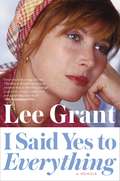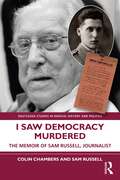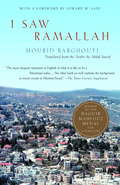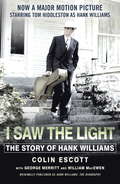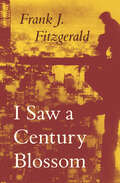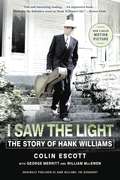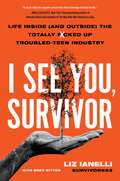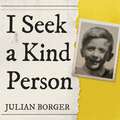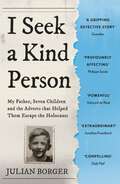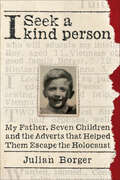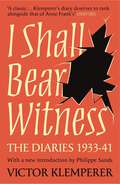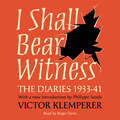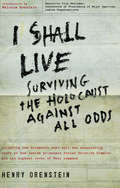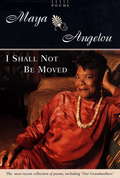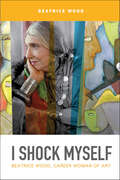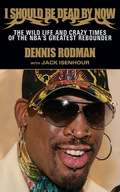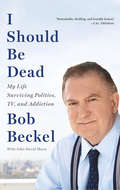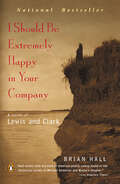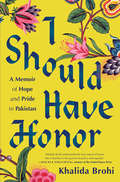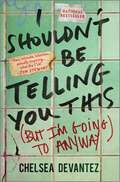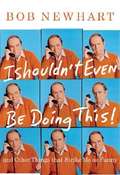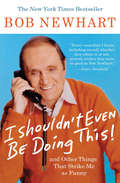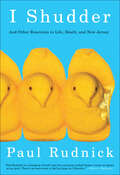- Table View
- List View
I Rise 2021 (French)
by Global Rainbow FoundationVéritable ambassadeur, spirituellement à l'écoute d'une foi indomptable dans le Divin, M. Armoogum consacre sa vie à élever, responsabiliser et célébrer notre peuple "défié". Son dévouement à l'humanité est le pilier de la Global Rainbow Foundation. Il s'est lancé dans la mission de repenser et de reconstituer la véritable essence du service à la société et à l'humanité. Son militantisme humain envers les droits de l'homme, la visibilité, l'égalité, l'acceptation et l'employabilité de nos amis handicapés physiques s'est intensifié sur une plate-forme internationale avec Maurice. Le GRF redéfinit la voix des personnes handicapées, dans une tentative désintéressée de les démarginaliser. GRF est leur voix amplifiée ; eux, ne restent plus silencieux et inaudibles. GRF est un havre de paix pour les personnes handicapées physiques qui jouissent au maximum de leur intégrité sociale.
I Said Yes to Everything
by Lee GrantBorn Lyova Haskell Rosenthal in New York City, actress Lee Grant spent her youth accumulating more experiences than most people have in a lifetime: from student at the famed Neighborhood Playhouse to member of the legendary Actors Studio; from celebrated Broadway star to Vogue "It Girl." At age twenty-four, she was nominated for an Academy Award for Detective Story, and a year later found herself married and a mother for the first time, her career on the rise. And then she lost it all. Her name landed on the Hollywood blacklist, her offers for film and television roles ground to a halt, and her marriage fell apart. Finding reserves of strength she didn't know she had, Grant took action against anti-Communist witch hunts in the arts. She threw herself into work, accepting every theater or teaching job that came her way. She met a man ten years her junior and began a wild, liberating fling that she never expected would last a lifetime. And after twelve years of fighting the blacklist, she was finally exonerated. With courage and style, Grant rebuilt her life on her own terms: first stop, a starring role on Peyton Place, and then leads in Valley of the Dolls, In the Heat of the Night, and Shampoo, for which she won her first Oscar. Set amid the New York theater scene of the fifties and the star-studded parties of Malibu in the seventies, I Said Yes to Everything evokes a world of political passion and movie-star glamour. Grant tells endlessly delightful tales of costars and friends such as Warren Beatty, Elizabeth Taylor, Grace Kelly, and Sidney Poitier, and writes with the verve and candor befitting such a seductive and beloved star.
I Saw Democracy Murdered: The Memoir of Sam Russell, Journalist (Routledge Studies in Radical History and Politics)
by Colin Chambers Sam RussellI Saw Democracy Murdered is the memoir of Sam Russell (1915–2010), a communist journalist and a British volunteer with the anti-fascist Republican forces in the Spanish Civil War. The book covers his experiences during the Spanish Civil War, his time as a journalist at The Daily Worker and The Morning Star newspapers, and his later disillusionment with Stalinism. In his capacity as a journalist, Russell travelled extensively and was frequently a front-row spectator at significant historical events, from the formerly occupied Channel Islands at the end of World War II to the show trials of communists in Eastern Europe in the 1950s. His report as Moscow correspondent on Nikita Khruschev’s ‘secret speech’ condemning the crimes of Stalinism was lacerated by his newspaper's editor, as was his interview with the legendary revolutionary leader, Che Guevara. Sam, whose friends included Donald Maclean, the British diplomat who spied for the Soviet Union during the Cold War, also reported from Budapest in 1956 and Prague in 1968 during the Warsaw Pact invasions of Hungary and Czechoslovakia, and from North Vietnam during the Vietnam War, and in 1973 he witnessed the assault on Chilean President Salvador Allende's palace that signalled the start of the CIA-backed military coup. Sam’s story was told to Colin Chambers and Chris Myant and has been edited by Colin Chambers. This autobiographical account of a fascinating life will be essential reading for scholars and activists with an interest in the Spanish Civil War, the history of communism, and British radical history.
I Saw Ramallah
by Mourid BarghoutiWINNER OF THE NAGUIB MAHFOUZ MEDAL FOR LITERATUREA fierce and moving work and an unparalleled rendering of the human aspects of the Palestinian predicament. Barred from his homeland after 1967&’s Six-Day War, the poet Mourid Barghouti spent thirty years in exile—shuttling among the world&’s cities, yet secure in none of them; separated from his family for years at a time; never certain whether he was a visitor, a refugee, a citizen, or a guest. As he returns home for the first time since the Israeli occupation, Barghouti crosses a wooden bridge over the Jordan River into Ramallah and is unable to recognize the city of his youth. Sifting through memories of the old Palestine as they come up against what he now encounters in this mere &“idea of Palestine,&” he discovers what it means to be deprived not only of a homeland but of &“the habitual place and status of a person.&” A tour de force of memory and reflection, lamentation and resilience, I Saw Ramallah is a deeply humane book, essential to any balanced understanding of today&’s Middle East.
I Saw The Light: The Story of Hank Williams - Now a major motion picture starring Tom Hiddleston as Hank Williams
by Colin EscottIn his brief life, Hank Williams created one of the defining bodies of American music. Songs like Your Cheatin' Heart, Hey Good Lookin' and Jambalaya sold millions of records and became the model for virtually all country music that followed.But by the time of his death at age twenty-nine, Williams had drunk and drugged and philandered his way through two messy marriages and out of his headline spot on the Grand Ole Opry. Even though he was country music's top seller, toward the end he was so famously unreliable that he was lucky to get a booking in a beer hall.After his death, Williams' records sold more than ever, and have continued to do so in the half-century since. His oft-covered catalog has produced hits for artists ranging from Fats Domino and John Fogerty's Blue Ridge Rangers to Ray Charles and B.J. Thomas; from Bob Dylan and jazz diva Norah Jones, to crooner Perry Como, R&B star Dinah Washington, and British punk band, The The.In this definitive account Colin Escott vividly details the singer's stunning rise and his spectacular decline, and reveals much that was previously unknown or hidden about the life of this country music legend.Now, over sixty years after his death, a major motion picture starring Tom Hiddleston and Elizabeth Olsen brings Hank Williams' tragic story to the screen. I Saw The Light first premiered at the Toronto International Film Festival and will be distributed by Sony Picture Classics in the UK.
I Saw a Century Blossom
by Frank J FitzgeraldA Brooklyn plumber born at the turn of the twentieth century looks back on his life in this 1984 memoir.Frank J. Fitzgerald was born in Greenpoint, Brooklyn, in 1902. As a teenager, he took a job as a plumber to support his family, and grew up quickly. His personal life and work gave way to many fascinating and unusual experiences. Now, in I Saw a Century Blossom, Fitzgerald recounts his storied years, tracing a path through pivotal events of the twentieth century and sharing a view of old New York not often seen in history books. Fitzgerald begins his account as the dust is still settling from the Spanish–American War and Theodore Roosevelt has taken office as president of the United States. He concludes with the 1980 presidential election. His perspective allows readers to see what happened in everyday life while countries fought world wars and disasters struck, like the Wall Street bombing of 1920 and the Black Tom explosion. Along the way, he experiences technological advents like modern plumbing. Tag along for his first job as a plumber, back when many employers were unwilling to hire Irish Americans. Meet Fitzgerald&’s interesting family and even see what a boy does for fun in early-twentieth-century Brooklyn, like swim in the East River. With stories that are sure to charm and entertain. I Saw a Century Blossom is a great choice for readers interested in New York City history and daily life during the early 1900s.
I Saw the Light: The Story of Hank Williams
by Colin Escott George Merritt William MacewenThe book that inspired the major motion picture I Saw the Light. Originally published as Hank William: The Biography.In his brief life, Hank Williams created one of the defining bodies of American music. Songs such as "Your Cheatin' Heart," "Hey, Good Lookin'," and "Jambalaya" sold millions of records and became the model for virtually all country music that followed. But by the time of his death at age twenty-nine, Williams had drunk and drugged and philandered his way through two messy marriages and out of his headline spot on the Grand Ole Opry. Even though he was country music's top seller, toward the end he was so famously unreliable that he was lucky to get a booking in a beer hall. Colin Escott's enthralling, definitive biograph--now the basis of the major motion picture I Saw the Light--vividly details the singer's stunning rise and his spectacular decline, revealing much that was previously unknown or hidden about the life of this country music legend.
I See You, Survivor: Life Inside (and Outside) the Totally F*cked-Up Troubled Teen Industry
by Liz Ianelli"A must read for anyone concerned about teenage mental health." -- Maia Szalavitz, NYT bestselilng author of Unbroken Brain co-author of The Boy Who Was Raised as a Dog A survivor of the Troubled Teen Industry exposes the truth about the dark side of a billion-dollar industry's institutionalized abuse—and shares the story of her own fight for justice. Liz Ianelli, known around the world as Survivor993, spent years at the Family Foundation—labeled an &“institution for troubled teens.&” The children who went through The Family School like her were good people. They had potential and dreams, but they came out with lifelong trauma: anxious, angry, paranoid, self-hating and in pain. Most of them have suffered lives of hardship, unable to integrate back into society. Hundreds have died, mostly by overdose and suicide.I See You, Survivor is about what really happened at The Family and what continues to happen at thousands of facilities like it. Beyond the trauma, this book is about triumph, resilience, and an effort to help others, and it conveys Liz&’s critical message for every survivor she sees:&“You are not broken. You are not unlovable. And you are not alone. There are millions of us. And I come with a message, for you, for them, for everyone: They act strong, but we are stronger. We are worthy. We are not alone. Speak, and we will be there for you. Speak, because there is power in your testimony. Speak, and we will win.&” This is a book first and foremost for survivors who can find support and community in these stories. It is also for parents, counselors, law makers and others to expose this industry for what it is: child abuse. And how that abuse has consequences for all of us.
I Seek a Kind Person: My Father, Seven Children and the Adverts that Helped Them Escape the Holocaust
by Julian BorgerAn original, investigative audio memoir by the Guardian's Pulitzer prize-winning World Affairs Editor, Julian Borger, to uncover the secrets of his family history and how the Holocaust determined the fate of their lives.'I SEEK A KIND PERSON WHO WILL EDUCATE MY INTELLIGENT BOY, AGED 11.'In 1938, Jewish families are scrambling to flee Vienna. Desperate, they take out adverts offering their children into the safe keeping of readers of a British newspaper, the Manchester Guardian. The right words in the right order could mean the difference between life and death.Eighty-three years later, Guardian journalist Julian Borger comes across the advert that saved his father, Robert, from the Nazis. Robert had kept this a secret, like almost everything else about his traumatic Viennese childhood, until he took his own life. Drawn to the shadows of his family's past and starting with nothing but a page of newspaper adverts, Borger traces the remarkable stories of his father, the other advertised children and their families, each thrown into the maelstrom of a world at war.From a Viennese radio shop to the Shanghai ghetto, internment camps and family homes across Britain, the deep forests and concentration camps of Nazi Germany, smugglers saving Jewish lives in Holland, an improbable French Resistance cell, and a redemptive story of survival in New York, Borger unearths the astonishing journeys of the children at the hands of fate, their stories of trauma and the kindness of strangers.I Seek a Kind Person is a gripping family memoir of grief, courage and hope, connecting us with multiple generations, distant continents and the hidden histories of our almost unimaginable past.(P)2024 Hodder & Stoughton Limited
I Seek a Kind Person: My Father, Seven Children and the Adverts that Helped Them Escape the Holocaust
by Julian Borger'A powerful, eloquent and deeply affecting book. I loved it' EDMUND DE WAAL'Tender, evocative and deeply moving' JONATHAN FREEDLAND'Profound, elegiac and fascinating... I zipped through it' PHILIPPE SANDS'Compelling' DAILY MAIL, BOOK OF THE WEEK'I SEEK A KIND PERSON WHO WILL EDUCATE MY INTELLIGENT BOY, AGED 11.' In 1938, Jewish families are scrambling to flee Vienna. Desperate, they take out adverts offering their children into the safe keeping of readers of a British newspaper, the Manchester Guardian. The right words in the right order could mean the difference between life and death.Eighty-three years later, Guardian journalist Julian Borger comes across the advert that saved his father, Robert, from the Nazis. Robert had kept this a secret, like almost everything else about his traumatic Viennese childhood, until he took his own life. Drawn to the shadows of his family's past and starting with nothing but a page of newspaper adverts, Borger traces the remarkable stories of his father, the other advertised children and their families, each thrown into the maelstrom of a world at war.From a Viennese radio shop to the Shanghai ghetto, internment camps and family homes across Britain, the deep forests and concentration camps of Nazi Germany, smugglers saving Jewish lives in Holland, an improbable French Resistance cell, and a redemptive story of survival in New York, Borger unearths the astonishing journeys of the children at the hands of fate, their stories of trauma and the kindness of strangers.I Seek a Kind Person is a gripping family memoir of grief, courage and hope, connecting us with multiple generations, distant continents and the hidden histories of our almost unimaginable past.
I Seek a Kind Person: My Father, Seven Children, and the Adverts that Helped Them Escape the Holocaust
by Julian BorgerThis gripping family memoir of grief, courage, and hope tells the hidden stories of children who escaped the Holocaust, building connections across generations and continents.In 1938, Jewish families are scrambling to flee Vienna. Desperate, they take out advertisements offering their children into the safe keeping of readers of a British newspaper, the Manchester Guardian. The right words in the right order could mean the difference between life and death.83 years later, Guardian journalist Julian Borger comes across the ad that saved his father, Robert, from the Nazis. Robert had kept this a secret, like almost everything else about his traumatic Viennese childhood, until he took his own life. Drawn to the shadows of his family's past and starting with nothing but a page of newspaper ads, Borger traces the remarkable stories of his father, the other advertised children, and their families, each thrown into the maelstrom of a world at war.From a Viennese radio shop to the Shanghai ghetto, internment camps and family homes across Britain, the deep forests and concentration camps of Nazi Germany, smugglers saving Jewish lives in Holland, an improbable French Resistance cell, and a redemptive story of survival in New York, Borger unearths the astonishing journeys of the children at the hands of fate, their stories of trauma and the kindness of strangers.
I Served on Bataan
by Juanita RedmondThe true story of an Army nurse trapped in the Philippines during the beginning of America's entrance in WWII.
I Shall Bear Witness: The Diaries Of Victor Klemperer 1933-41
by Victor KlempererA publishing sensation, the publication of Victor Klemperer's diaries brings to light one of the most extraordinary documents of the Nazi period.'A classic ... Klemperer's diary deserves to rank alongside that of Anne Frank's' SUNDAY TIMES'I can't remember when I read a more engrossing book' Antonia Fraser'Not dissimilar in its cumulative power to Primo Levi's, is a devastating account of man's inhumanity to man' LITERARY REVIEWThe son of a rabbi, Klemperer was by 1933 a professor of languages at Dresden. Over the next decade he, like other German Jews, lost his job, his house and many of his friends.Klemperer remained loyal to his country, determined not to emigrate, and convinced that each successive Nazi act against the Jews must be the last. Saved for much of the war from the Holocaust by his marriage to a gentile, he was able to escape in the aftermath of the Allied bombing of Dresden and survived the remaining months of the war in hiding. Throughout, Klemperer kept a diary. Shocking and moving by turns, it is a remarkable and important account.
I Shall Bear Witness: The Diaries Of Victor Klemperer 1933-41
by Victor KlempererA publishing sensation, the publication of Victor Klemperer's diaries brings to light one of the most extraordinary documents of the Nazi period.'A classic ... Klemperer's diary deserves to rank alongside that of Anne Frank's' SUNDAY TIMES'I can't remember when I read a more engrossing book' Antonia Fraser'Not dissimilar in its cumulative power to Primo Levi's, is a devastating account of man's inhumanity to man' LITERARY REVIEWThe son of a rabbi, Klemperer was by 1933 a professor of languages at Dresden. Over the next decade he, like other German Jews, lost his job, his house and many of his friends.Klemperer remained loyal to his country, determined not to emigrate, and convinced that each successive Nazi act against the Jews must be the last. Saved for much of the war from the Holocaust by his marriage to a gentile, he was able to escape in the aftermath of the Allied bombing of Dresden and survived the remaining months of the war in hiding. Throughout, Klemperer kept a diary. Shocking and moving by turns, it is a remarkable and important account.
I Shall Live: Surviving the Holocaust Against All Odds
by Henry OrensteinI Shall Live tells the gripping true story of a Jewish family in Germany and Russia as the Nazi party gains power in Germany. When Henry Orenstein and his siblings end up in a series of concentrations camps, Orenstein's bravery and quick thinking help him to save himself and his brothers from execution by playing a role in the greatest hoax ever pulled on the upper echelons of Nazi command.Orenstein's lucid prose recreates this horrific time in history and his constant struggle for survival as the Nazis move him and his brothers through five concentration camps. His description of their roles in the fake Chemical Commando sheds new light on an incredible and generally unknown event in the history of the Holocaust. This edition of I Shall Live contains new evidence about this false Commando, including letters signed to and from Himmler himself.
I Shall Not Be Moved: Poems
by Maya AngelouIn her first book of poetry since Why Don't You Sing? Maya Angelou, bestselling author of the classic autobiography I Know Why The Caged Bird Sings, writes with lyric, passionate intensity that reaches out to touch the heart and mind. This memorable collection of poems exhibits Maya Angelou's unique gift for capturing the triumph and pain of being black and every man and woman's struggle to be free. Filled with bittersweet intimacies and ferocious courage, these poems are gems—many-faceted, bright with wisdom, radiant with life.
I Shock Myself: Beatrice Wood, Career Woman of Art
by Beatrice WoodIn her own charming, spirited, and readable style, Beatrice Wood tells us the story of her unorthodox life and her influence on 20th-century art. Rebellious, radical, and romantic, Wood (1893–1998) defied propriety to become a true national, and international, treasure. Her absorbing autobiography includes vintage documents and her own personal photos and sketches of her many famous friends and acquaintances in the art world. She became romantically involved with the Dadaist Marcel Duchamp, and offers rare glimpses into the lives of her circle, including key cultural figures like Constantin Brancusi, Isadora Duncan, Edna St. Vincent Millay, Anais Nin, and Krishnamurti. At age forty Wood studied ceramics and went on to become one of the major ceramists of the 20th century, working until her death at age 105. This captivating chance to enjoy Wood's rare charisma and spirit provides a better understanding of American art and the people who have shaped it.
I Should Be Dead By Now: The Wild Life and Crazy Times of the NBA's Greatest Rebounder of Modern Times
by Dennis Rodman Jack IsenhourWhether it was helping Michael Jordan and the Chicago Bulls win three consecutive NBA titles in the 1990s, or showing up to a book signing in a dress and full makeup, Dennis Rodman has always distinguished himself as one of the great and most polarizing personalities in the sports world. The controversial and flamboyant former basketball star is back in the national spotlight once again with I Should Be Dead By Now. This riveting book from the two-time best-selling author details Rodman's struggles in life since he stopped playing in the NBA, including the breakup of his marriage to movie and TV star Carmen Electra, and his problems with alcohol. I Should Be Dead By Now is a look at the life of one of America's most recognizable sports stars as he journeys beyond the court and into the Naismith Basketball Hall of Fame.
I Should Be Dead: My Life Surviving Politics, TV, and Addiction
by Bob Beckel John D. MannFrom popular TV personality Bob Beckel, a deeply moving, redemptive memoir about his life as a political operative and diplomat, his long struggle with alcohol and drugs, and his unlikely journey to finding faith. Growing up poor in an abusive home, Bob Beckel learned to be a survivor: to avoid conflict, mask his feelings, and to lie--all skills that served him well in Washington, where he would become the youngest-ever Deputy Assistant Secretary of State and manage Walter Mondale's 1984 presidential campaign. But Beckel was living a double life. On January 20, 2001--George W. Bush's first Inauguration Day--he hit rock bottom, waking up in the psych ward. Written with captivating honesty, Beckel chronicles how his addictions nearly killed him until he found help in an unexpected ally, conservative Cal Thomas, who helped him find faith, get sober, and get his life back on track. Channel, The Five.
I Should Be Extremely Happy in Your Company: A Novel of Lewis and Clark
by Brian HallA sweeping, gorgeously written novel of Lewis and Clark's legendary expedition, named one of the best novels of the year by The Boston Globe, Salon, The Los Angeles Times, and The Christian Science Monitor.Brian Hall&’s compulsively readable novel vividly re-creates Lewis and Clark&’s extraordinary journey into the unknown western frontier. Focusing on the emblematic moments of the participants&’ lives, the story unfolds through the perspectives of four competing voices—from the troubled and mercurial figure of Meriwether Lewis, the expedition leader who found that it was impossible to enter paradise without having it crumble around him, to Sacagawea, the Shoshone girl-captive and interpreter for the expedition, whose short life mirrored the disruptive times in which she lived. Bringing the day-to-day life of the expedition alive as no work of history ever could, Hall&’s magnificent novel fills in the gaps and provides a new perspective on the most famous journey in American history.
I Should Have Honor: A Memoir of Hope and Pride in Pakistan
by Khalida BrohiA fearless memoir about tribal life in Pakistan—and the act of violence that inspired one ambitious young woman to pursue a life of activism and female empowerment “Khalida Brohi understands the true nature of honor. She is fearless in her pursuit of justice and equality.”—Malala Yousafzai, winner of the Nobel Peace Prize From a young age, Khalida Brohi was raised to believe in the sanctity of arranged marriage. Her mother was forced to marry a thirteen-year-old boy when she was only nine; Khalida herself was promised as a bride before she was even born. But her father refused to let her become a child bride. He was a man who believed in education, not just for himself but for his daughters, and Khalida grew up thinking she would become the first female doctor in her small village. Khalida thought her life was proceeding on an unusual track for a woman of her circumstances, but one whose path was orderly and straightforward. Everything shifted for Khalida when she found out that her beloved cousin had been murdered by her uncle in a tradition known as “honor killing.” Her cousin’s crime? She had fallen in love with a man who was not her betrothed. This moment ignited the spark in Khalida Brohi that inspired a globe-spanning career as an activist, beginning at the age of sixteen. From a tiny cement-roofed room in Karachi where she was allowed ten minutes of computer use per day, Brohi started a Facebook campaign that went viral. From there, she created a foundation focused on empowering the lives of women in rural communities through education and employment opportunities, while crucially working to change the minds of their male partners, fathers, and brothers. This book is the story of how Brohi, while only a girl herself, shone her light on the women and girls of Pakistan, despite the hurdles and threats she faced along the way. And ultimately, she learned that the only way to eradicate the parts of a culture she despised was to fully embrace the parts of it that she loved.Advance praise for I Should Have Honor“Khalida Brohi’s moving story is a testament to what is possible no matter the odds. In her courageous activism and now in I Should Have Honor, Khalida gives a voice to the women and girls who are denied their own by society. This book is a true act of honor.”—Sheryl Sandberg, COO of Facebook and founder of LeanIn.Org and OptionB.Org
I Shouldn't Be Telling You This: (But I'm Going to Anyway)
by Chelsea DevantezA NATIONAL BESTSELLER&“I could not put this book down. It&’s so funny&” –Ru Paul&“I LOVE this book for its honesty and dark (and light!) comedy&” –Rachel Dratch (Instagram)"It&’s f*cking great!!! Raw, intimate, hilarious, actually inspiring.&” –Jon StewartA RECOMMENDED READ FROM: NPR * PUREWOW * USWEEKLY * PEOPLE * BUSTLE * SHEREADS * NYLON * BOOKRIOT * AND MOREThe dynamic memoir-in-essays by comedian, screenwriter, and podcaster Chelsea Devantez, detailing her tumultuous upbringing and uproarious career path into Hollywood.There are things Chelsea Devantez probably shouldn&’t be telling you. Many of them are in this book: some are embarrassing (like when she tried to break her three year spell of celibacy using a guide of seduction tips). Some are confessional (getting sentenced to the &“hell hill&” at Mormon church camp). Some are TMI (a series of outrageous doctor visits that ended with one doctor misdiagnosing her as &“pregnant.&” Woopsies!).Then there are things Chelsea really shouldn&’t be telling you: like the time her biggest family secret was publicly outed, or about the drive-by shootings and the precipitating domestic violence she survived. Yet through it all, it&’s the women in Chelsea&’s life who kept her going – from the lowest points of her childhood when she and her mom had only $100 left to their name, all the way to her career highs as the Emmy-nominated Head Writer for The Problem with Jon Stewart and sensational podcaster deemed &“the celebrity memoir whisperer&” by her fans. In I Shouldn't Be Telling You This, Chelsea centers each story around a different woman who shaped her life, taking us on a tour of friends and strangers, fictional characters and celebrities, heroes and villains who will destroy any Netflix algorithm for a &“strong female lead.&” Reading it will feel kinda like that moment at a party when your friend beckons you close, sloshes her martini around, and covertly whispers, &“I really shouldn&’t say this, but…&”
I Shouldn't Even Be Doing This!: And Other Things That Strike Me as Funny
by Bob NewhartMost comedians are committable. People say I'm the most normal of all comedians-and I'm still certifiable. -from Chapter One That stammer. Those basset-hound eyes. That bone-dry wit. There has never been another comedian like Bob Newhart. In this, his first book ever, Newhart gives his brilliant and bemused twist on a multitude of topics, including flying, the trials of a family holiday in a Winnebago, and more serious subjects, such as golf. And, of course, there are side-splittingly funny stories from his life and career. Who else has a drinking game named after him? ("Hi, Bob!") Newhart starts with his windy Chicago childhood: Like most kids, I didn't pay much attention in church. Until I was an adult, I thought that St. Christopher was the patron saint of magnetic feet because you stuck him on the dashboard and he wouldn't move. He writes of his few years as an accountant (he routinely grew so frustrated trying to reconcile petty cash that he would round up and down using his own pocket change). He describes his surprise at the groundbreaking success of his albums, starting with The Button-Down Mind of Bob Newhart, which was the first comedy album ever to hit #1 on the charts and won the Grammy for Album of the Year (beating Sinatra). There are stories from the legendary television shows, which spent fifteen years on prime time, and tales of other comedy greats. And as counterpoint throughout, he provides excerpts from some of his classic routines, which revolutionized comedy: Abraham Lincoln's Press Agent: What else, Abe?... You changed "four score and seven" to "eighty-seven"?... I understand it means the same thing, Abe. That's meant to be a grabber... Abe, we test-marketed that in Erie and they went out of their minds..." This isn't a memoir like most memoirs. It's a book only Bob Newhart could have written, with his unique worldview and irrepressibly wry humor on every page. Oh, and there's a fair bit of plain silliness, too.
I Shouldn't Even Be Doing This!: And Other Things That Strike Me as Funny
by Bob NewhartThe first book ever from an icon of American comedy--a hilarious combination of stories from his career and observations about lifeThat stammer. Those basset-hound eyes. That bone-dry wit. There has never been another comedian like Bob Newhart. His comedy albums, movies, and two hit television series have made him a national treasure and placed him firmly in the pantheon of comedy legends. Who else has a drinking game named after him And now, at last, Newhart puts his brilliant and hysterical world view on paper.Never a punch-line comic, always more of a storyteller, he tells anecdotes from throughout his life and career, including his beginnings as an accountant and the groundbreaking success of his comedy albums and The Bob Newhart Show and Newhart, which gave him fifteen years on primetime television. And he also gives his wry, comedic twist to a multitude of topics, including golf, drinking, and family holidays.Today, Newhart appears on Desperate Housewives, in hit movies such as Elf, and in theaters around the country. Reruns of his shows air constantly on Nick at Nite--have recently been released with great success for the first time ever on DVD. With this book, Bob Newhart gives his millions of fans a first ever opportunity to sample his unique brand of humor--including excerpts from some of his classic routines--on the printed page.
I Shudder: And Other Reactions to Life, Death, and New Jersey
by Paul RudnickComic essays from the author of Farrell Covington and the Limits of Style: &“There&’s no book wiser or half as funny as I Shudder.&” —David Sedaris I Shudder is a side-splittingly funny collection of essays from Paul Rudnick, one of America&’s preeminent humorists—a playwright, screenwriter, novelist, and regular contributor to the New Yorker. The reviews say it all: &“A hilarious, often touching hodgepodge of essays about his work and his life with his pleasingly demented family.&” —People (4 stars) &“Uproariously self-deprecating essays about being gay and Jewish in suburban New Jersey and downtown Manhattan.&” —The New York Times Book Review &“A likable and accomplished raconteur who never loses sight of his own absurdity.&” —The Washington Post &“Smart, dishy, and very funny.&” —Daily News &“An acerbic and entertaining memoir.&” —Entertainment Weekly &“I Shudder is filled with deeply funny musings and adventures that elevate Paul Rudnick to the highest level of American comedy writing. It should be noted that I would be at the highest level of American comedy writing if I had had Paul&’s early advantages.&” —Steve Martin

